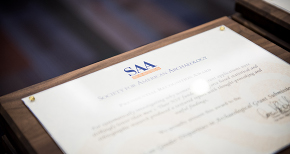More than Fill: Using GIS and Historical Documents in Urban Archaeology [Foundational Skills]
When: September 21, 2023 1:00-2:00 PM ET
Duration: 1 hour
Certification: RPA-certified
Pricing
Individual Registration: Free to SAA members; $69 for non-members
Group Registration: Free to SAA members; $89 for non-members
Ms. Knight-Iske is an archaeologist and cultural resources specialist at Stell, with over 13 years of professional experience in the field of cultural resources and archaeology. She has performed Phase I-, II-, and III-level archaeological investigations/surveys as Field Director, Crew Chief and Artifact Lead and has performed field and laboratory work on multiple sites of proposed land development areas throughout Maryland, New Jersey, Virginia, Pennsylvania, Washington D.C., and West Virginia. She also has experience using ArcGIS for cultural resources, natural resources, and archaeological purposes. Ms. Knight-Iske has worked for and/or collaborated with the Armed Forces Retirement Home, Department o Homeland Security, District of Columbia Historic Preservation Office, General Service Administration, Maryland Historical Trust, West Virginia SHPO, Maryland State Highway Administration, National Park Service, Naval Support Facility at Indian Head, Nebraska State Historical Society, New Jersey State Historic Preservation Office (SHPO), Office of Historic Alexandria, Office of Historic Preservation of Arlington County, Pennsylvania Department of Transportation (PennDOT), University of Nebraska State Museum, U.S. Forest Service, U.S. Army Corps of Engineers, Washington State Department of Archaeology & Historic Preservation, multiple Tribal Historic Preservation Offices, and national, state, and local avocational and professional organizations.
- Discuss how urban archaeology is conducted
- Bring to light underutilized GIS analyses for use in CRM archaeology
- Describe how different kinds of historical documents can help build a better site history
![Experimenting with GIS and Neighborhood Reconstruction at Cerro Amole, a Prehispanic Urban Center in Oaxaca [SALSA]](/images/default-source/default-library/default-online-seminar.tmb-seminar.png?Culture=en&sfvrsn=40097a1a_1)
Registration Closed!
Experimenting with GIS and Neighborhood Reconstruction at Cerro Amole, a Prehispanic Urban Center in Oaxaca [SALSA]
When: September 15, 2023 8:00-9:00 PM ET
Duration: 1 hour
Certification: None
Pricing
Individual Registration: Free to SAA members; not available to non-members
Group Registration:
Soren Frykholm, University of Michigan
While intermediate levels of social organization—above the household, but below the entire city or polity—are notoriously difficult to pinpoint in archaeological contexts, they nevertheless represent a crucial frontier for archaeological theory building. Ethnographic research demonstrates that informants recognize these intermediate levels, such as the “neighborhood,” and that they consider them important. Critical to forming social identity, integrated social communities also have high potential for collaboration. In Mesoamerica, organizational units such as the Mixtec siqui, Aztec calpulli, and Maya tzukub were recognized in social, economic (tribute), and military systems. But how do we conceptualize, investigate, and identify these ethnohistorically documented social units archaeologically?
Between 2013 and 2017, archaeologists used GPS units to map Cerro Amole, a Postclassic (AD 800-1521) urban center in the Mixteca Alta of Oaxaca, Mexico. In addition to thousands of terraces, more than 750 structures were recorded along with ancient roads, platforms, patios, and surface artifacts. In this lecture, I will discuss three GIS-based methods of neighborhood reconstruction at Cerro Amole, including Kernel Density (KD), Least Cost Analysis (LCA), and watersheds. Rather than prioritizing a single model for its ability to shed light on ancient social organization, I argue that the interpretive ability of these methods is enhanced when considered together.
![The Practice and Ethics of Skeletal Excavation and Conservation [Deeper Digs]](/images/default-source/opengraph/onlineseminars/laboratory.tmb-seminar.png?Culture=en&sfvrsn=13f10fec_2)
Registration Closed!
The Practice and Ethics of Skeletal Excavation and Conservation [Deeper Digs]
When: September 15, 2023 2:00-4:00 PM ET
Duration: 2 hours
Certification: RPA-certified
Pricing
Individual Registration: $99 for SAA members; $149 for non-members
Group Registration: $139 for SAA members; $189 for non-members
Dr. Miller Wolf is a bioarchaeologist and UWF Assistant Professor of Anthropology. She specializes in the study of skeletal remains from archaeological sites to answer cultural questions about the past and has extensive experience with conservation and curation of collections at U.S. and Latin American institutions. She was a Fulbright U.S. Scholar to Honduras (2022) for ongoing research of the largest collection of ancient Maya human skeletal remains yet recovered in Mesoamerica at Copan, Honduras and to teach bioarchaeological field and laboratory methods to students from the Universidad Nacional Autónoma de Honduras. She was awarded the Conservation and Heritage Management Award (2020) by the Archaeological Institute of America for her decades long conservation project in Honduras and other sites in Latin America. She has also conducted research on skeletal samples from sites in North Africa, Mississippian and Woodland sites in the Lower Illinois River Valley, and historic sites within Florida and Belize.
Carolyn Freiwald, PhD, University of Mississippi
Dr. Carolyn Freiwald earned her PhD at the University of Wisconsin-Madison and focuses on animal use, migration, and diet in Mesoamerica. She is an Associate Professor of Anthropology at University of Mississippi. Her specialty is biogeochemistry using the chemical composition of osseous remains to reconstruct behaviors in the past. She is also interested in the conservation and care of anthropological materials, and works with museum collections in Wisconsin, Mississippi, and Latin America.
- Review best practices for excavation, transport, sampling, and cleaning human skeletal remains drawing from real world examples
- Describe best practices for long-term conservation and curation of skeletal remains drawing from real world examples
- Discuss the importance of long-term conservation strategies for collections and our
ethical obligations as archaeologists



![More than Fill: Using GIS and Historical Documents in Urban Archaeology [Foundational Skills]](/images/default-source/opengraph/onlineseminars/maps_overlay.tmb-seminar.png?Culture=en&sfvrsn=5bc5ec88_1)